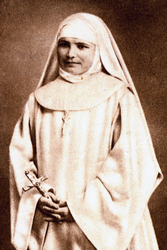Lives of the Saints
Our Models and Protectors
Spiritual Bouquet:
April 8

Blessed Mary Assunta
Franciscan Missionary
(1878-1905)
Saint Pius X promulgated his decree Quam Singulari, recommending frequent Holy Communion for all and early First Communion for children, just two years after the death of Blessed Mary Assunta. This holy young nun, especially devoted to the Blessed Sacrament in her youth, though she could not yet benefit from the decree, is a living proof to the wisdom of his decision. Saints among children and youth, whom he foretold would multiply, have always had such devotion, and thus God shows us that it is not the number of years that counts. Rather it is intensity of love, and the practice of spiritual childhood, in the spirit of Saint Thérèse of the Child Jesus, which please God.
Maria Assunta Pallotta was born in Italy in 1878, during the octave of the Assumption. The oldest of five children, she was always calm, gentle, peaceful, never seen to have fits of anger or caprice, never disobedient. Her parish priest would say later: Every Sunday afternoon, when the church was deserted, we would find little Assunta kneeling there, praying; then she would go to the catechism lessons and help him to instruct the youngest little ones. Frequent visits to the Blessed Sacrament marked all the years of her youth. At the age of fifteen she already had the maturity of an adult, being very serious and hard-working; she was wearing a hair shirt often, and fasting three times a week, even sleeping on stones.
To answer the call of the Lord which she heard while still young, she perhaps would not have been able to free herself from the many duties involved in the life of a poor family, had not a kind prelate, when he visited her village, taken her cause in hand. He obtained her admission without a dowry to the Franciscan Missionaries of Mary, whose mother house was in Rome. She was twenty years old at that time.
Always smiling and cheerful, she became a subject of edification for all. She scarcely knew how to read and write and was assigned to very humble tasks: with love she cared for the animals and did the laundry. Ever more humble, she would often go to ask for permission to do supplementary penances to expiate her sins, which permission was ordinarily refused. But she would return again to ask, and she made a vow to do everything for love of God, consecrating herself to His Sacred Heart.
One day in 1904 she requested of her Mother General to remember her when there would be a mission to the lepers, to whom her institute devoted itself. She was sent to China in that same year, to the mission where seven of her Sisters had already shed their blood for Christ four years before. Her beautiful resolutions prove her sanctity: I came to the convent to become a Saint: to what purpose would I live a long time if I did not attain my goal? I will therefore not pass up anything profitable for my soul, though the whole world be given me in exchange. Never will I excuse myself, never speak of myself, imitating the Most Blessed Virgin in humility and charity toward God and neighbor.
Soon the cross re-appeared in the peaceful halls of the orphanage, in the form of a typhus epidemic; and in March of 1905 three of the six newly-arrived Sisters were ill. Two departed for their heavenly reward, including the youngest of them all, and Sister Mary Assunta was the third to fall ill. She immediately asked for the Last Sacraments, saying she would die in a few days. Her condition afterwards seemed to improve, but after a week of severe sufferings, she too expired in peace. An odor of flowers was noted shortly before her death; it soon filled the room and the entire house. The Sisters were impressed, and when her body was exhumed in 1913 it was found virtually intact, though the robe was disintegrating. Miracles followed, and Mary Assunta was beatified by Pope Pius XII in November, 1954.
Soeur Marie-Assunta, Franciscaine Missionnaire de Marie, by the Sisters of her Community, Paris, 1924